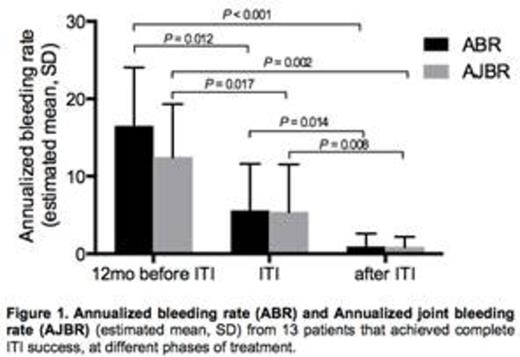Abstract
Introduction: Despite treatment of hemophilia having achieved considerable improvement over the last decades, inhibitor development remains a major complication for these patients. Inhibitors are alloantibodies that neutralize factor (F) VIII coagulation activity, and occur in approximately 25% of hemophilia A patients. Immune tolerance induction (ITI) is the choice therapy to eradicate these antibodies. There are several ITI protocols with similar success rates, approximately 70%. The presence of long-standing inhibitors in the adult population has usually been associated with poor ITI outcome. In Brazil, as in other countries with constrained resources, limited access to factor concentrates prevented the use of ITI. Thus, almost all patients with inhibitors remained a long time with this complication. Only after 2013 with increased availability of factor concentrates in the country, has assured long-term prophylaxis and ITI treatment been possible.
Objective: This study aimed to describe the Brazilian experience in managing ITI in adult patients from seven Hemophilia Treatment Centers with long-standing inhibitor using bypassing agents to control bleeding episodes, considering bleeding frequency, treatment barriers and economic impact of therapy.
Patients and Methods: We retrospectively analyzed clinical and laboratory data of hemophilia A patients with high-responding inhibitors (peak titer > 5 Bethesda Unit (BU), anamnestic response to FVIII) over 18 yo who underwent ITI treatment and were using bypass agents before ITI. The initial ITI protocol used was low-dose FVIII concentrate (25-50 IU/kg 3x/week)
Results: In Brazil, since the availability of ITI, 39 adult hemophilia A patients with inhibitors, have been submitted to ITI for the first time. In this study, we accessed data from 26 patients, of these 13 (50%) already achieved complete ITI success criteria (inhibitor titer < 0.6 BU; FVIII recovery ≥ 66%, and half-live ≥ 6 h). Another 4 patients with ongoing ITI achieved inhibitor titer < 5 BU and are no longer using bypassing agents. Thus, 17/26 (65%) patients discontinued the bypassing agents in a median period of 2 mo (range 0 to 18 mo) after starting ITI. After 24 months of irregular treatment 2 patients abandoned ITI protocol. Analyses of the 13 patients with complete success revealed mean age at first reported inhibitor of 16.21y (SD ± 11.6; median 21y, range 0.7 to 37y), and mean age at ITI onset of 31.2y (SD ± 10.6; median 27y, range 19 to 47y). The mean period from the first inhibitor detected until starting ITI was 15y (SD ± 5.1), with a 16y median (range 7 to 22y). The historical peak inhibitor mean was 53.1 BU (SD ± 49.5; median 39.4 BU, range 5.5 to 163 BU). The mean pre ITI inhibitor titer was 6.6 BU (SD ± 5.5; median 5.5 BU, range 0.6 to 20.8 BU). Low-dose ITI protocol was initially used for all patients, however 3 patients had the dose increased during treatment (100 IU/kg from 3 to 7 x/week). During ITI, 10/13 patients received prophylaxis with bypassing agents, and 9 began prophylaxis before ITI started. The mean time to achieve inhibitor titer < 0.6 BU was 11.6 mo (SD ± 12.5; median 7 mo, range 0.5 to 44 mo). All 13 patients achieved other ITI success criteria. However, a delay was observed in the majority of patients in FVIII recovery and half-life. Regarding clinical outcome, we observed a significant reduction in both, annualized bleeding rate (ABR), and annualized joint bleeding rate (AJBR), comparing 12 months before ITI, during ITI, and after achieving complete success (figure 1). Regarding economic evaluation, we observed a significant reduction in the median cost of clotting factor consumption, comparing 12 months before starting ITI, and the following years after achieving ITI success. No significant difference was observed between the median cost of 12 months before, and ITI period (figure 2).
Conclusion: This study indicated that this treatment is worthwhile even for inhibitor patients with poor prognostic factors for ITI considering both effectiveness to control and prevent bleeding episodes, and economic impact. In this group, 65% of adult hemophilia A high-responding inhibitors patients stopped using bypassing agents after a median period of 2 months after starting ITI. Despite being a high cost treatment, ITI can be cost-effective, especially for patients using bypassing agents. These results reinforce the positive impact of the ITI even in long time inhibitor adult patients.
Ozelo:Baxter: Membership on an entity's Board of Directors or advisory committees, Speakers Bureau; Novo Nordisk: Research Funding, Speakers Bureau; Biogen: Research Funding.
Author notes
Asterisk with author names denotes non-ASH members.



This feature is available to Subscribers Only
Sign In or Create an Account Close Modal